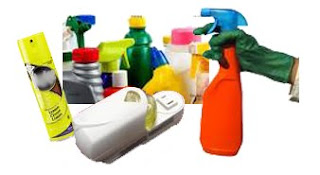 Many experts agree that what many people mistakenly call allergies are actually a reaction to everyday toxins. Dr. Kenneth D. Rosenman, MD, Chief of the occupational and environmental medicine division at Michigan State University says that, "Most household products aren't tested to see if they cause lung reactions or asthma." "Furthermore, manufacturers aren't required to list any ingredients except disinfectants."
Many experts agree that what many people mistakenly call allergies are actually a reaction to everyday toxins. Dr. Kenneth D. Rosenman, MD, Chief of the occupational and environmental medicine division at Michigan State University says that, "Most household products aren't tested to see if they cause lung reactions or asthma." "Furthermore, manufacturers aren't required to list any ingredients except disinfectants."As a result, your home likely contains dozens of contaminants that can cause anything from itchy skin to asthma. It could be your air freshener or beauty products.
 They may smell sweet, but when it comes to your health, synthetic fragrances stink. A 2007 study of six fragranced consumer products discovered that the cleansers emitted nearly a hundred different volatile organic compounds (VOCs), chemicals released as gas. These included acetaldehyde and 1,4-dioxane, which cause immediate eye, skin, and airway irritation. And weekly use of common glass cleaners, furniture sprays, and air fresheners has been linked to a 30 percent to 50 percent increased risk of adult asthma. Plug-in air fresheners, in particular, emit a constant cloud of VOCs called terpenes, a class of pine- or lemon-scented plant oils. While not themselves toxic, terpenes off-gas formaldehyde when mixed with ozone, resulting in watery eyes, wheezing, and inflamed airways. That said, current consumer laws don't require labels to list VOCs or fragrances — even if they cause respiratory problems.
They may smell sweet, but when it comes to your health, synthetic fragrances stink. A 2007 study of six fragranced consumer products discovered that the cleansers emitted nearly a hundred different volatile organic compounds (VOCs), chemicals released as gas. These included acetaldehyde and 1,4-dioxane, which cause immediate eye, skin, and airway irritation. And weekly use of common glass cleaners, furniture sprays, and air fresheners has been linked to a 30 percent to 50 percent increased risk of adult asthma. Plug-in air fresheners, in particular, emit a constant cloud of VOCs called terpenes, a class of pine- or lemon-scented plant oils. While not themselves toxic, terpenes off-gas formaldehyde when mixed with ozone, resulting in watery eyes, wheezing, and inflamed airways. That said, current consumer laws don't require labels to list VOCs or fragrances — even if they cause respiratory problems.Avoid using ionizing air purifiers, which can produce indoor ozone, a molecule that is highly reactive when placed in contact with other substances — especially air fresheners that emit terpenes.
Instead, neutralize odors with Boston ferns, bamboo palms, and spider plants, which also absorb toxins such as formaldehyde and benzene. Instead of sprays and aerosols, use essential oils diluted in water to reduce your exposure to airborne chemicals.
 Essential oils make superb natural household cleansers with their germ fighting abilities. The easiest way to mix them is to add essential oils to a spray bottle filled with water, shake it, and spray whatever needs cleaning. Or create a high concentration (about 40 to 60 drops per 4 ounces of water) and use as an air freshener. To clean dishes, floors, and counters, add a touch of unscented dish soap and 5 to 10 drops of the oil of your choosing to a sink filled with 1 to 3 gallons of hot water. Another good option for people who want that clean-house smell but don't want to bombard their family with synthetic fragrance: Add oils to unscented dish soap and laundry detergent. For example, mix 3 to 5 drops of the essential oil of your choice with an unscented laundry detergent before each load.
Essential oils make superb natural household cleansers with their germ fighting abilities. The easiest way to mix them is to add essential oils to a spray bottle filled with water, shake it, and spray whatever needs cleaning. Or create a high concentration (about 40 to 60 drops per 4 ounces of water) and use as an air freshener. To clean dishes, floors, and counters, add a touch of unscented dish soap and 5 to 10 drops of the oil of your choosing to a sink filled with 1 to 3 gallons of hot water. Another good option for people who want that clean-house smell but don't want to bombard their family with synthetic fragrance: Add oils to unscented dish soap and laundry detergent. For example, mix 3 to 5 drops of the essential oil of your choice with an unscented laundry detergent before each load.A drop of lavender or frankincense adds a light aromatic touch to clean laundry. But for cleaning purposes, I prefer lemon or lemongrass, which are antimicrobial and have an uplifting, energizing effect. Always wear rubber gloves when cleaning with lemongrass, as it can cause dermatitis in sensitive skin. Tea tree, is revered for its antimicrobial properties, is another effective option
 Sodium laurel sulfate (SLS) this foaming and cleansing detergent found in shampoo, body wash, and toothpaste may cause instant irritation to the skin, eyes, and mucous membranes and can eventually become an allergen. And because your skin and your airways aren't entirely separate, SLS may trigger respiratory symptoms as well. Similar chemicals found in foaming bath products include diethanolamine, monoethanolamine, and triethanolamine.
Sodium laurel sulfate (SLS) this foaming and cleansing detergent found in shampoo, body wash, and toothpaste may cause instant irritation to the skin, eyes, and mucous membranes and can eventually become an allergen. And because your skin and your airways aren't entirely separate, SLS may trigger respiratory symptoms as well. Similar chemicals found in foaming bath products include diethanolamine, monoethanolamine, and triethanolamine.Reactions include redness, swelling, and burning sensations which look the same whether caused by chemical irritants or allergy. Irritants, however, provoke an immediate reaction, while allergies can require weeks of constant exposure to develop.
Avoid these reactions by choosing products that contain natural foaming agents, such as coconut-derived lauric acid.
Formaldehyde, the same toxic preservative used in embalming is added to most nail polishes and mascaras to inhibit bacteria growth. Whether it's applied to wounded or broken skin (think cracked cuticles) or inhaled as a gas (wet nail polish), formaldehyde is responsible for the largest proportion — more than 25 percent — of cosmetic-instigated contact dermatitis and allergic reactions, according to a recently published study. Skin reactions can occur on eyelids, neck, and face, while fumes irritate eyes, nose, and throat.
Choose nail polishes and removers that use gentler polyester resins instead of formaldehyde-releasing preservatives such as tosylamide formaldehyde, quaternium-15, diazolidinyl urea, and DMDM hydantoin.
Check out the Whole Foods website for a wide variety of natural body care products and home cleaning solutions.
Have you alleviated everyday toxins in your house? How did you identify the offensive toxins?




